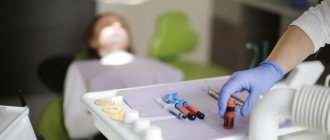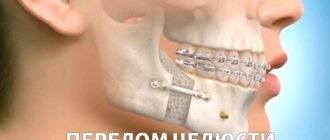2261
Inflammation of the periosteum (periosteum) is the most common complication that develops against the background of advanced caries.
The condition is dangerous because it is asymptomatic for some time, gradually affecting first the inner layer of the periosteum, and then the outer one.
The process is serious and very dangerous, requiring immediate attention to the dentist and periostotomy.
The essence of the operation
Periostotomy, or otherwise called periosteotomy, is a dental procedure performed by a dental surgeon when a local purulent focus (phlegmon, abscess, gumboil), necrotic areas in the jaw or in the periosteum (periosteum) occurs.
The periosteum is a connecting two-layer film. In its upper layer there are nerve fibers and blood vessels that transmit nerve impulses to the brain and supply the upper part of the jaw bone with nutrients. The lower layer contains osteoblast cells.
When the inflammatory process begins, the upper layer of the periosteum is initially affected, characterized by a pulsating pain symptom. If you do not seek medical help at this time, the inflammation affects the lower layer and then spreads to the bone tissue.
Very often, bone changes in this disease become irreversible. To prevent such an outcome, a periostotomy is performed.
The operation is a tooth-preserving procedure. The technique of its behavior involves dissection of the periosteum to cut the abscess, create a free outflow of purulent mass from the inflamed area, and also to gain access to the jaw bone.
More about the procedure
The periosteum is a connective film consisting of two layers. The upper one includes blood vessels and nerve fibers that supply the upper jaw and transmit impulses to the brain. The lower one contains osteoblast cells. During the inflammatory process, the upper layer is the first to be affected, which leads to acute pain. If treatment is not carried out in a timely manner, the lower layer and bone tissue are affected.
Periostotomy is a tooth-saving operation. During its implementation, a free outflow of pus from the inflamed area is created.
Indications
Most often, surgical intervention is dictated by the development of inflammation in the periosteum and the formation of gumboil - swelling of the gum tissue next to the problem tooth, and the concentration of pus in this place.
In addition, surgery will be justified in the following conditions:
- Actinomycosis of the periosteum and jaw , when, after treating the source of inflammation, the overgrown bone is eliminated.
- Jaw periostitis of the serous type , in which the periosteum is opened to reduce tension in the dental tissues and prevent suppuration.
- Inflammation after closing the dental canals with a filling - the periosteum is cut to prevent swelling.
- Abscess (purulent periostitis), in which the opening of the periosteum is performed in order to create an outlet for the leakage of exudate.
- Resection of the upper region of the root , where periostotomy is the first stage of a complex operation to obtain an approach to the root apex, in which, after opening the periosteum, the bone is cut out.
Periosteotomy is also part of the complex treatment of certain pathologies and an additional surgical procedure:
- radicular cyst;
- neoplasms in the jaw;
- sinus lift;
- bone grafting;
- prosthetics on implants.
The main signs of a radicular dental cyst and methods for its elimination.
Find out here when hemisection of a tooth is justified.
At this address https://www.vash-dentist.ru/hirurgiya/udalenie-zubov/nyuansyi-slozhnogo-mudrosti.html we’ll talk about possible problems after complex wisdom tooth removal.
Preparation
Before periostotomy, the doctor performs X-ray diagnostics to assess the anatomy of the periosteum, its condition, and the location of inflammation. After receiving the data and analyzing it, the patient is recommended to undergo surgery. To perform it, it is necessary to pass a number of tests standard for any surgical intervention.
The process takes place under local anesthesia. If the inflammation is in the upper jaw, then pain relief is done bilaterally. If the lower jaw is affected, mandibular or torusal anesthesia is performed (in the area of the lower jaw ridge).
Contraindications
Surgical intervention is not performed if the patient has the following contraindications:
- blood cancer (leukemia);
- hemophilia (hereditary blood incoagulability);
- malignant formations in the oral cavity, head and neck, as well as radiation therapy for this diagnosis;
- CNS vasculitis;
- cardiovascular pathologies and diabetes mellitus at the stage of decompensation;
- acute respiratory diseases.
People suffering from mental disorders and addiction to alcohol and drugs will be denied surgery.
Important! All of these limitations are not specific to periostotomy, but are general in nature for all dental operations.
Preparatory procedures
Before surgery, the patient must undergo radiography. This examination allows you to assess the outline, size, shape, structure and extent of inflammation, as well as determine the condition of the periosteum itself, the degree of necrotic changes in it and neighboring tissues.
Based on the results of this examination, the surgeon draws up a plan for the operation, calculates its duration, and decides on the type of anesthesia.
Studying the general condition of the patient is of no small importance for the outcome of the operation. For this purpose, he is asked to undergo the following tests:
- for HIV infection;
- HCW and HBS;
- RW;
- clinical and biochemical blood tests with mandatory indication of total protein, albumin, bilirubin, AST, ALT, cholesterol, glucose, amylase, creatinine, prothrombin.
- coagulogram;
- ECG.
Technique
Periostotomy is performed only in a hospital setting by a dental surgeon. The whole process consists of the following steps:
- Anesthesia. Local anesthesia is administered by injection - classic or conduction.
- Treatment of the operated surface and oral cavity with an antiseptic.
- Cutting the mucous membrane in the area of inflammation , and in case of an extensive process, the incision is made about 2 cm, for a small lesion - up to 1 cm. Their dissection is carried out along the location of the alveolar processes, and the periodontal tissue is cut to its entire thickness, i.e. to the jaw bone.
- Peeling of the periosteum - for this, a trowel (a blunt dental instrument) is used.
- Cleaning and treating the resulting cavity with antiseptic drugs (usually Furacilin or a solution of potassium permanganate).
- Introducing drainage into the wound (its role is played by a latex and rubber tourniquet), which is necessary for the outflow of purulent mass and preventing the wound from healing.
- Removing the drainage from the wound - it is removed only after the cavity is cleansed (this can sometimes take more than one day).
- Application to the wound of applications with regenerating and anti-inflammatory drugs that have a local effect.
- Stitching the edges of the wound (carried out only if it is large).
Important! In severe (advanced) cases, when an abscess has developed, drainage is also inserted into the tooth. After the complete release of pus, the dentist always treats the problem unit.
The duration of the surgical procedure depends entirely on the complexity of the case, but its approximate duration is 30-40 minutes.
Advantages and disadvantages of piezosurgery for tooth extraction, procedure for carrying out the procedure.
In this article we will talk about the indications for gingivectomy and the cost of the operation.
Here https://www.vash-dentist.ru/hirurgiya/udalenie-zubov/stomatolog-kto-eto-i-chto-delaet.html we will find out what a dentist surgeon does.
Progress of the operation
The duration depends on the complexity of the condition; on average, the operation takes 30-40 minutes. Stages:
- anesthesia;
- treatment of the cavity with antiseptics;
- tissue dissection by 1-2 cm;
- peeling of the periosteum;
- cleaning and treating the cavity with antiseptics (“Furacilin”, potassium permanganate solution);
- installation of drainage to prevent wound healing.
A few days after the cavity is completely cleansed, the drainage is removed and an application with anti-inflammatory and regenerating drugs is applied. If the wound is too large, stitches are applied.
Advantages
Since periostotomy is a tooth-saving operation, it has significant advantages over those procedures during which the tooth is removed:
- The problematic unit that caused the inflammation to begin is completely preserved. Moreover, its functional ability is also fully preserved.
- The operation is quick and absolutely safe for health.
- Minimal damage to healthy tissue.
- There is no pain symptom due to high-quality pain relief.
- The patient’s postoperative recovery (his ability to work) and wound healing are faster.
- The number of days in hospital is reduced to a minimum - no more than three days.
Flaws
Tooth-preserving technologies have become popular in dentistry in recent years. Despite many advantages, the operation to open the periosteum has some disadvantages:
- The area being operated on is limited in visibility.
- A deep incision of periodontal tissues (in severe cases) negatively affects the speed of recovery and healing.
- The height of the alveolar ridge decreases slightly.
- The necks of the teeth are exposed.
- Hyperesthesia of the inner part of the tooth (dentine) develops.
Possible complications
Inflammation of the periosteum is dangerous due to the manifestation of severe consequences for the body in case of untimely seeking medical help. But the development of complications is not excluded even after treatment.
The main cause of postoperative complications is the further progression of inflammation and its spread to adjacent tissues and even bone.
They usually occur when treatment is started late, insufficient opening of the abscess, incomplete emptying and drainage of pus.
These consequences include:
- Tooth loss . In the case of frequent recurrence of inflammation, in which there is an expansion of the affected area, the dentist decides to remove this unit.
- Osteomyelitis (otherwise inflammation of bone tissue). It develops when infection penetrates from dental tissue to the surrounding bone.
If the infection spreads through the blood throughout the body, osteomyelitis can affect any of the bones.You can suspect the development of this complication by high fever, acute pain in the bone next to the problem tooth.
- Sinusitis is inflammation of the maxillary sinuses. Its first symptoms are a runny nose, nasal congestion, pain in the face, and high fever.
- Blockage of the cavernous sinus is a phenomenon when a blood vessel in the brain becomes infected and becomes blocked with blood clots of varying sizes.
- Ludwig's tonsillitis is a rare but life-threatening complication.
The cause of the development of the condition is infection of the tissues of the floor of the oral cavity. Dysphagia (problems with swallowing), swelling of the oral tissues, pain with tongue movements, fever, and swelling of the neck develop. In extremely severe cases, breathing difficulties and narrowing of the airways appear.
Treatment of all these conditions consists of a full medicinal and physiotherapeutic complex.
Complications can also develop due to mistakes by the doctor himself during the operation:
- improper placement of drainage, preventing the normal release of pus;
- errors in determining the cut area;
- very deep tissue dissection.
Important! To prevent postoperative complications, the autopsy should be performed by an experienced and qualified specialist.
Bone augmentation before implantation or, in other words, osteoplasty is one of the main surgical specialties of our dental center. We have written many articles about it and, for starters, we highly recommend that you familiarize yourself with the basic ones:
– Bone augmentation before implantation – what do patients need to know about this?
– – Part I explains what osteoplasty is, when it is needed and in what cases it is unnecessary, what is a contraindication to this operation and how it is planned.
– – Part II talks about the methods of osteoplastic surgery, highlighting three main ones: guided bone regeneration, autotransplantation and osteotomy, and describes their similarities, differences and effectiveness.
– – Part III explains what biomaterials, barrier membranes and artificial bone tissue are, where they come from, what they are made of, what they are intended for and how they are used.
If you have a negative attitude towards bloody pictures and other dismemberment, see articles using the hashtag “osteoplasty” on our clinic’s website.
If you adore Quentin Tarantino’s films, and the sight of blood doesn’t scare you, welcome to the IMPLANT-IN.COM website, the hashtag is the same, “osteoplasty,” but the more detailed articles contain information mainly for doctors.
Today, dear friends, I invite you to discuss an important issue
– How long should I wait after osteoplasty? And when, after bone tissue augmentation, can implantation be done?
The topic is actually very simple. But, for some reason, there is no clear opinion on this matter. One doctor says that you need to wait 3 months, another, no less authoritative, says. that the optimal period is 6 months, the third, even more famous than the previous two, recommends waiting 9 months after osteoplasty, and only then proceeding with implantation.
When I just started my professional career in the field of implantology, it was customary for us to wait 6-8 months after osteoplasty. Now we calmly begin implantation 3-4 months after bone tissue augmentation - and, I must note, that the effectiveness of implant treatment not only has not worsened, but has even become better. Not to mention the fact that osteoplastic surgery as a separate stage is a rather rare intervention, because, basically, we try to carry out all the necessary procedures simultaneously with implantation. You can read more about this in the corresponding article - “Implantation and osteoplasty - together or apart?”, Part I and Part II. I can talk about this endlessly (after all, these are the most common surgical operations in our clinic), but today we will talk specifically about osteoplasty as a stage of treatment identified as a separate intervention.
I recommend you remember this and this article. And also read about what happens to the patient after we complete the surgery.
If you are too lazy to follow the links, then I will remind you that in the last phase of post-operative inflammation, regenerative processes in bone tissue are launched - there is an active migration of cells, protoosteoblasts and osteoblasts, division and transformation of some of them into osteocytes, vessels, nerves and etc. In the context of regeneration, we will be interested in two types of cells:
– osteoblasts , actively dividing and capable of movement, bone tissue cells and their precursors, proto-osteoblasts (fibroblasts of the first order, protofibroblasts, osteoblasts of the first order - they have a million names).
- osteocytes , static cells, incapable of movement and division, which are the end product of osteoblast differentiation, producing osteomatrix - that very solid intercellular substance that we, in fact, call bone.
In general terms, you should know that an osteoblast can turn into an osteocyte, but an osteocyte cannot turn into an osteoblast without special chemistry. The osteoblast moves and divides - then turns into an osteocyte, after which it stops dividing. At the same time, ostecyte has an important function - it produces the hard component of bone.
You don’t have to be too smart to understand that the harder the bone, the more osteocytes and fewer osteoblasts it contains. The “dense” the bone tissue is, the worse it regenerates. I have written about this hundreds of thousands of times, constantly focusing on the fact that “loose” bone tissue is really bad, but very “dense and hard” bone tissue, from the point of view of regeneration, is complete crap.
Bone tissue is heterogeneous in its structure even in one person.
And, of course, its cellular composition is uneven - in the cortical layer there are more osteocytes (this makes it regenerate worse), and in the underlying spongy layer there are more osteoblasts (therefore, “loose” bone tissue is practically not subject to atrophy and regenerates much better). In addition, at different times and different ages, the ratio of cells can also be different.
After osteoplasty, during the regeneration process, the cell content changes nonlinearly:
That is, if some time after osteoplasty, due to active division, differentiation from protofibroblasts and migration, the content of osteoblasts (read, actively dividing cells) is quite high, then, over time, some of them turn into osteocytes and stop dividing. But, at the same time, the “density” of bone tissue increases, since newly appeared osteocytes produce a solid intercellular substance.
Let me remind you that for the regeneration and osseointegration of implants we need osteoblasts - it is due to their division that the implant “grows” into the jaw bone. And, if you consider that 3-4 months after osteoplasty the content of osteoblasts is definitely higher than after 6-8 months, then it’s a no-brainer that with implantation after 3-4 months the chances of successful integration of the implant are greater than if the same procedure is carried out the operation itself in six months or more.
See for yourself. The photo below shows the edge of the tooth socket, about a month after extraction. New bone tissue is formed along its perimeter (I also already wrote about this - and here’s a visual demonstration!), but so far it is poorly mineralized and is not visible on an x-ray. In terms of its physical properties, it is more reminiscent of cartilage, and some doctors confuse it with granulations and scrape it out, which is absolutely not allowed:
On the one hand, it is not easy to achieve primary stability of the implant under such conditions. But, if we don’t plan an immediate load, why do we need primary stability? On the other hand, this very osteoid is dominated by actively dividing cells, osteoblasts and fibroblasts, there is active growth of blood vessels and nerves, all regenerative processes are at their peak - isn’t this the best time to install an implant? After all, all we need is cell division. It is due to this that bone restoration, ingrowth of biomaterials, integration of implants, etc. occurs.
And yet, you will probably have a question: “Does everyone who suggests waiting 6-8 months or longer not know all this? Aren’t you D’Artagnan, Stanislav Vasiliev?”
No. Not D'Artagnan. More like Don Quixote. You see, all of us, including the coolest dentists, live in a world of stereotypes, rules and dogmas, some of which we cannot explain. Once upon a time, someone, very smart, said that “the higher the primary stability of the implant, the better,” and we all took him at his word, without even trying to refute his words. Although everyone has long known that there are implantation systems that do not imply achieving primary stability at all.
The same goes for the waiting period after osteoplasty. Once upon a time there lived a certain professor Tsur Brannemarkovich Urbanyan. One day, he tried to put a crown on an implant 2 months after its installation. The implant rotated. “Fuck! – said Tsur Brannemarkovich, “We need to wait longer!”, after which he reported at the international congress that from implantation to crown you need to wait 4 months on the lower jaw and 6 months on the upper jaw. And everyone believed him, no one tried to verify or refute this statement. However, I also wrote about this in “Features of the Future.”
But you need to check. We must endlessly ask ourselves the question: “Why?” and answer it clearly and understandably, at least to yourself. We must endlessly search for the reasons not only for our own failures, but also for successful results. "WHY?" - these are the most important questions in the life of not only a doctor, but also any person with an analytical and critical outlook on life.
I'll show you a simple example from practice:
In other words, for successful implantation there is no need to wait for the complete maturation and mineralization of bone tissue. It is much more correct, from all points of view, to start it earlier, while the number of osteoblasts is high enough and the regenerative capabilities are at their peak. It’s clear that this very “peak” is a purely individual thing, and for different people it will occur at different times, but it’s worth remembering that:
– the longer we wait after osteoplasty, the denser our regenerate becomes, the higher its mineralization, the fewer dividing osteoblasts and the more non-dividing osteocytes it contains.
– the harder and denser the bone tissue, the worse it regenerates.
– the higher the torque (moment of force) when installing an implant, the worse it is, and in too dense bone tissue, an increase in torque is inevitable.
Therefore, if you ask me how long you need to wait after osteoplasty before proceeding with implantation, I will answer:
3-4 months, no more.
This way, you will not only speed up dental rehabilitation, but also make it more predictable.
Thank you for reading to the end. I am ready to answer all your questions in the comments to this article.
Best regards, Stanislav Vasiliev
What else should I read about bone tissue augmentation before implantation?
– what do you need to know before consulting an implantologist?
– consultation with an implantologist
– cost of dental implantation at CLINIC IN
– cost of surgical operations at CLINIC IN
– implants and biomaterials we work with
Recovery period and care
In order for the postoperative period to proceed quickly and correctly, the patient is required to follow the following simple recommendations:
- For the first 2-3 hours after the procedure is completed, do not eat or drink anything except plain water.
- In the following days, all food should have a mushy consistency (i.e., be ground) and warm (not hot).
- Apply cold to the cheek in the area of surgery for the entire first day (for no more than 20 minutes with a break of the same duration).
- Strictly follow all doctor's prescriptions, take painkillers and antibiotics, and do not skip physical therapy sessions (warming, laser therapy, UHF).
- During the entire healing period, rinse your mouth with antiseptic solutions and decoctions of medicinal herbs (“Furacilin”, potassium permanganate, decoctions of chamomile, oak bark, sage, etc.).
- It is also necessary to make baths of soda after each snack: 1 tsp. Dissolve food water in 200 ml of water, put it in your mouth and hold for 40-50 seconds, spit (and so on several times for 5-7 minutes). Rinsing should not be intense.
- Avoid physical activity, sports, baths and saunas.
- Don't miss doctor visits.
On average, the period of human recovery and wound healing lasts from 4 to 6 days.
Its duration can be influenced by several factors - the complexity of the disease itself, the extent of inflammation, and the patient’s correct compliance with medical prescriptions.
Rehabilitation
For the first two hours, eating and drinking (except water) is not recommended. In the future, food should be soft, preferably pureed. All food and drinks should be at room temperature.
The doctor also prescribes painkillers and antibiotics. Rinse only when indicated. If the process was difficult and the healing process is difficult, physiotherapy is prescribed.
If you conscientiously follow all the doctor’s recommendations, the recovery period takes 4-6 days.
Prices
Opening the periosteum is performed in many dental clinics, since it does not require the use of special equipment.
The operation is an inexpensive dental service. Its cost starts from 800 rubles and can reach up to 2 thousand rubles. The final figure will depend on the complexity of the pathology.
You will have to pay separately for a consultation with a specialist - from 300 rubles, tooth extraction (if necessary), and this is another approximately 1100 rubles - for a simple extraction and 2-3 thousand rubles. - for difficult.
The cost of radiography is approximately 600-800 rubles, anesthesia - from 1 thousand rubles. (depending on the type of anesthesia and the amount of drug administered).
Reviews
Periostotomy is a simple standard dental operation, the technology of which has been worked out quite well.
It helps stop the inflammatory process when other methods of treating inflammation in the periosteum do not bring results.
You can share your feedback and impressions about this manipulation and the features of the recovery period in the comments to this article.
If you find an error, please select a piece of text and press Ctrl+Enter.
Tags: toothache, dental surgery
Did you like the article? stay tuned
Previous article
Steel crowns on teeth are one of the reliable restoration options
Next article
Replantation or an effective method of returning a tooth to its place
Cost of services
Surgery Price
Periostotomy of the tooth: indications and features of the operation from 1500 rub.
Expert of the article you are reading:
Akhmedkhanov Said Rashidovich
Dental surgeon, general dentist, implantologist, orthopedic dentist, dental therapist.
You may also be interested in:
Wisdom tooth removal Tooth extraction Removal of the dental nerve Complex tooth extraction Resection of the apex of the tooth root Removal of an impacted tooth Removal of the tooth root Removal of a dystopic tooth
Show more










